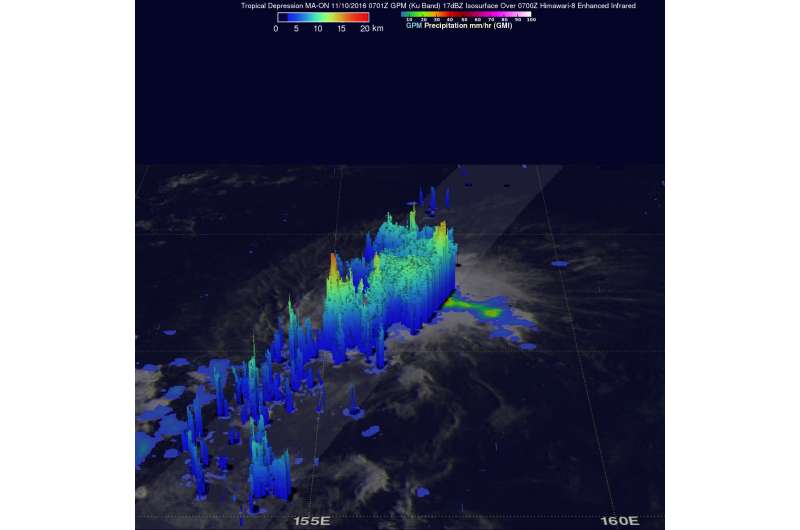NASA sees heavy rain in Tropical Depression Ma-on

Tropical cyclones have been forming frequently in the Western Pacific Ocean since July 2016. Thirty-six named tropical cyclones have formed in the Western Pacific in less than five months with 14 of them becoming typhoons.
Tropical Depression Ma-on formed on Nov. 10, 2016, northeast of Guam. Ma-on had maximum sustained winds estimated at 30 knots (34.5 mph) when the Global Precipitation Measurement mission or GPM core observatory satellite flew over on Nov. 10, 2016, at 2:01 a.m. EST (0701 UTC). GPM's Microwave Imager (GMI) and Dual-Frequency Precipitation Radar (DPR) instruments showed that the tropical depression contained some very heavy showers. Strong bands of convective storms were shown spiraling into Ma-on. GPM's radar (Ku Band) found rain falling at a rate of over 198 millimeters (7.8 inches) per hour in an area east of the tropical depression's center.
The GPM satellite's 3-D radar data were used to evaluate the structure of rainfall within tropical depression Ma-on. Parameters such as storm top heights, vertical profiles of rainfall, and freezing levels are among the values that are measured. Storm tops of many convective storms were shown by GPM's Ku Band radar to reach heights above 16 km (9.9 miles). GPM is a joint mission between NASA and the Japan Aerospace Exploration Agency (JAXA).
On Nov. 10 at 10 a.m. EST (1500 UTC) the Joint Typhoon Warning Center (JTWC) said that Ma-on was located near 17.5 degrees north latitude and 154.4 degrees east longitude. That's about 594 miles east-northeast of Andersen Air Force Base, Guam. Ma-on is moving to the west at 13 knots (14.9 mph/24.0 kph) and winds were still near 30 knots (34.5 mph).
JTWC predicts that Ma-on will strengthen to tropical storm intensity by Nov. 11, 2016. Ma-on is predicted to move over the open waters of the Pacific toward the northwest and dissipate in a couple of days.
Provided by NASA's Goddard Space Flight Center



















